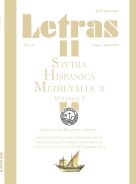Please use this identifier to cite or link to this item:
https://repositorio.uca.edu.ar/handle/123456789/5028| Título: | La travesía del caballero andante : mapas e itinerarios en el Amadís de Gaula | Autor: | Valenzuela Munguía, María del Rosario | Palabras clave: | Amadís de Gaula; LITERATURA ESPAÑOLA; LITERATURA MEDIEVAL; LIBROS DE CABALLERIA; LITERATURA DE VIAJES | Fecha de publicación: | 2015 | Editorial: | Universidad Católica Argentina. Facultad de Filosofía y Letras | Cita: | Valenzuela Munguía, María del Rosario. “La travesía del caballero andante : mapas e itinerarios en el Amadís de Gaula” [en línea]. Letras, 71 (2015). Disponible en: https://repositorio.uca.edu.ar/handle/123456789/5028 | Resumen: | Resumen: Por antonomasia, el caballero es andante. Dicha característica lo convierte en un viajero que recorre geografías reales y ficticias. De este modo, el libro de caballerías teje sus redes con la literatura de viajes. Podría pensarse que con respecto a este género, la geografía queda supeditada al mundo de lo fantástico; sin embargo, en este trabajo se pretende revisar cuáles son los espacios transitados por el personaje principal de los Cuatro libros de Amadís de Gaula, para saber si, dentro de la obra, existe una geografía de valor simbólico que permita construir un contexto más realista. Así, una serie de especificidades en la descripción del espacio permitiría que haya concordancias entre el mundo literario y el imaginario cultural del lector, lo que haría del Amadís una obra en la que Rodríguez de Montalvo muestra una entidad espacial conocida por sus lectores para dar comienzo a uno de los géneros literarios más exitosos del siglo XVI. Abstract: The knight is errant par excellence. Because of this, he is a traveler of real and fictitious geographies. In this way chivalric books intertwine with travel literature. In regard to this genre, we might think that geography depends on the realm of the fantastic; yet this paper aims to explore the places visited by the main character of the Cuatro libros de Amadís de Gaula, in order to know whether there is a symbolic geography that reveals a more realistic context. Thus, a series of specifications in the description of space would allow the correspondence between the literary world and the reader’s cultural imaginary, which would imply that Rodríguez de Montalvo knew this and managed to start one of the most popular literary genres in the XIVth century. |
URI: | https://repositorio.uca.edu.ar/handle/123456789/5028 | ISSN: | 0326-3363 | Disciplina: | LITERATURA | Derechos: | Acceso Abierto | Fuente: | Letras Nº 71, 2015 |
| Appears in Collections: | LETRAS - 2015 nro. 71 |
Files in This Item:
| File | Description | Size | Format | |
|---|---|---|---|---|
| travesia-caballero-andante.pdf | 74,96 kB | Adobe PDF |  View/Open |
Page view(s)
349
checked on Apr 30, 2024
Download(s)
66
checked on Apr 30, 2024
Google ScholarTM
Check
This item is licensed under a Creative Commons License

